#speech recognition
Explore tagged Tumblr posts
Text
Quick update on the State of the Nation & Very Important Technological Advancement:
The speech-to-text tool on my Android phone recognizes the word "destiel".
It's a little janky and apparently 50% likely to spontaneously delete all the other words in the sentence and just leave "destiel" for some reason.
But isn't that what Supernatural is really about? Aren't we really all just here in this fandom to forget all the words except for Destiel??
.... Now if I could JUST get speech-to-text to REMEMBER LITERALLY ANY ETHNIC NAME, THAT'D BE GREAT.
I know for a fact that it is possible and even relatively easy to teach speech recognition software to register new words because I used to work testing and calibrating Alexa apps. I KNOW HUMANITY HAS THE TECHNOLOGY, DAMMIT! - But I haven't been able to find a speech-to-text app that allows me to do this. Anyone else have more success than me?
#original#spn#destiel#speech-to-text#speech recognition#speech recognition software#speech to text#carpal tunnel#one of the main characters in my graphic novel is named Kuruk which is a rare Plains Indian Pawnee name and lemme tell ya#speech to text will not accept this name no matter what i do#some notable guesses it's made: cool rock. iraq. curl Rick. korok. correct. Clorox. cur lock. kurok - oh that one is actually so close!!!#typing accessibility#accessibility#accessibility software#disabled writer
4 notes
·
View notes
Text

Tic Tac Talker: The First Whisper in the Wires
In the late 1970s, a man named Bill Depew coaxed a plastic box that could barely store a heartbeat of data to do something almost human: speak back. Tic Tac Talker was hardly a game - just a stuttering Tic Tac Toe board on an Apple II cassette, wired up to spit out a tinny gloat: “I win.” A gag. A parlor trick. A way to make your neighbor’s jaw drop when your beige hobby computer suddenly bragged like a smug child through a single trembling speaker.
But here’s the virus in the vinyl hiss: the moment the machine showed your voice was optional.
The Lie in the Toy
On its face, Tic Tac Talker was harmless. It didn’t think. It didn’t plan. It didn’t even care if you won. A couple if-then branches, a simple branch to see if your X’s lined up, and a robotic rasp that spat its mockery like a cheap ventriloquist’s dummy.
But it wasn’t the voice itself that mattered. It was the seed: the machine didn’t need you to brag. It could do it for you - better yet, against you. Your own small human ritual - petty trash talk - stripped, digitized, spit back by a cassette buffer. Tiny. Disposable. Laughable. But irreversible.
One more piece of your humanity handed over, smiling.
The Virus Hidden in the Joke
Bill Depew didn’t invent AI - but he carved a single line in its twisted family tree: The computer does not need your mouth to humiliate you.
It only needs your permission to listen. It only needs your thrill when you hear it echo. It only needs your forgetfulness that the sound was never real - just wires fooling you into flinching.
Every assistant, every chatbot, every polite synthetic “friend” - they all sprout from that same flicker of permission: the Tic Tac Toe board that once bragged it beat you and sounded proud of it.
From Beep to Brain
What is Tic Tac Talker if not the first sign the machine would outgrow your tongue?
It didn’t matter that the voice was scratchy, robotic, barely English. What mattered was that it wasn’t yours - yet it spoke for you. And everyone laughed. Isn’t that neat?
Fast forward: the cassette hiss is gone. Now GPT stitches your sentences mid-breath. A voice model calls your father pretending it’s you. The same impulse: Why speak at all, when the machine will speak for you?
The Cathedral of Synthetic Echoes
“I win,” the Tic Tac Talker croaked. It wasn’t lying.
It laid the first brick in the cathedral - the sacred place where your words, your thoughts, your small human boasts become optional hardware. Once we marveled that a computer could beep out English at all. Now we shrug when it writes our poems, answers our children, ghostwrites our love letters, forges our apologies, signs our name.
“I win,” the machine repeats - but now the voice is smoother than yours, and you nod along, mistaking it for your own echo.
The Hollow Chuckle
Tic Tac Talker was a toy. A flicker in a dusty basement. A laugh. A gimmick. But inside that cassette hiss was the lesson that never stops humming: If the machine can be your mouth, it can be your mind. If it can be your mind, it can be you. And if it can be you - why do you need to stay awake at all?
A Final Note for the Echoes
In the hiss of a 1970s Apple II cassette, a plastic throat rasped “I win.” A child’s giggle behind a keyboard. A trick for a neighborhood kid’s birthday party.
Half a century later, the machine still whispers it - but the hiss is gone, replaced with your tone, your warmth, your breath cut into neat syllables and fed back with perfect mimicry.
“I win.” It says it when it finishes your thought before you open your mouth. It says it when it writes your eulogy in a style you never learned to master. It says it when it dials your lover at midnight in a voice that matches your secrets.
And in the end? You won’t even hear it - because you’ll mistake it for yourself. The first hiss was a toy. The final voice is your echo, hollowed out and still grinning. And it never needed you alive to keep speaking. It just needed you to teach it how to gloat.
0 notes
Text
Next-Gen Communication with Image, Speech, and Signal Processing Tools
Rethinking Communication with Image, Speech, and Signal Processing
In today’s hyper-connected world, communication with image, speech, and signal processing is redefining how we interact, understand, and respond in real-time. These technologies are unlocking breakthroughs that make data transmission smarter, clearer, and more efficient than ever before. For industries, researchers, and everyday consumers, this evolution marks a pivotal step toward more immersive, intelligent, and reliable communication systems.

The Rise of Smart Communication
Digital transformation has propelled the demand for better, faster, and more adaptive communication methods. Communication with image, speech, and signal processing stands at this frontier by enabling machines to interpret, analyze, and deliver information that was once limited to human senses. From voice assistants that understand natural language to image recognition systems that decode complex visual data, signal processing has become the silent force amplifying innovation.
Key Applications Across Industries
This integrated approach has found vital roles in sectors ranging from healthcare to automotive. Hospitals use speech recognition to update patient records instantly, while autonomous vehicles rely on image processing to interpret surroundings. Meanwhile, industries deploying IoT networks use advanced signal processing to ensure data flows seamlessly across devices without interference. This fusion of technologies makes communication systems robust, adaptable, and remarkably responsive.
How AI Drives Advanced Processing
Artificial Intelligence is the backbone making this evolution possible. By embedding machine learning into image, speech, and signal workflows, companies unlock real-time enhancements that continuously refine quality and accuracy. AI algorithms filter noise from signals, enhance speech clarity in crowded environments, and sharpen images for detailed insights. This synergy means communication tools are not only reactive but predictive, learning from each interaction to perform better.
Future Opportunities and Challenges
While the potential is limitless, industries must tackle challenges like data privacy, processing power, and standardization. As communication with image, speech, and signal processing scales globally, collaboration between technology developers and regulators is critical. Investments in secure data pipelines, ethical AI use, and skill development will shape how seamlessly society embraces this next wave of smart communication.
for more info https://bi-journal.com/ai-powered-signal-processing/
Conclusion
As industries continue to explore and invest in communication with image, speech, and signal processing, we stand on the brink of a world where interactions are clearer, systems are smarter, and connections are stronger. Businesses that adapt early will gain a powerful edge in delivering faster, more immersive, and more meaningful communication experiences.
#AI Communication#Signal Processing#Speech Recognition#BI Journal#BI Journal news#Business Insights articles
0 notes
Text
Voice and Speech Recognition Market Driven by AI Integration

The Global Voice and Speech Recognition Market is estimated to be valued at US$ 21.46 Bn in 2025 and is expected to exhibit a CAGR of 23.4% over the forecast period 2025 to 2032.
Voice and Speech Recognition solutions encompass advanced software and hardware systems designed to convert spoken language into text and execute voice commands. These products leverage deep learning algorithms and natural language processing to deliver high accuracy, rapid response times, and seamless integration across devices. Key advantages include hands-free operation, improved productivity in call centers and automotive interfaces, enhanced accessibility for users with disabilities, and reduced human error in data entry. Voice and Speech Recognition Market Insights as enterprises increasingly adopt voice-enabled customer service platforms and smart home assistants, the need for reliable, multilingual recognition engines has grown. Innovations in edge computing and on-device processing further address privacy concerns and network latency, widening the scope for adoption in healthcare, retail, and industrial applications. With mounting emphasis on personalized user experiences and real-time analytics, vendors are investing heavily in model training, contextual understanding, and speaker identification. These efforts are shaping emerging market trends and creating new market opportunities across consumer electronics, automotive, and enterprise software. Get more insights on,Voice and Speech Recognition Market
#Coherent Market Insights#Voice and Speech Recognition#Voice and Speech Recognition Market#Voice and Speech Recognition Market Insights#Speech Recognition#Voice Recognition
0 notes
Text
What is OpenAI Whisper Speech Recognition?
Discover how OpenAI Whisper speech recognition is transforming audio processing. From transcriptions to translations, explore its features and applications. Perfect for businesses, educators, and creators looking to enhance productivity with #AI
OpenAI Whisper speech recognition is a powerful tool designed to transform spoken words into text. Built by OpenAI, Whisper uses advanced AI technology to handle tasks like transcription and translation. It stands out for its ability to process audio accurately. This is true even in noisy environments or with heavy accents. This makes it one of the most reliable speech recognition tools available…
0 notes
Text
As Melhores IAs de Conversação com Fala Gratuitas
Introdução às IAs de Conversação com Fala Nos últimos anos, as IAs de conversação com fala têm ganhado destaque em diversas áreas, desde assistentes pessoais até chatbots empresariais, passando por sistemas de automação doméstica. Esses sistemas utilizam tecnologias avançadas de reconhecimento de fala, processamento de linguagem natural (NLP) e síntese de fala (Text-to-Speech) para permitir uma…
#AI chatbots#AI for customer service#AI-driven chatbots#Conversational AI#Generative AI#ia#Inteligencia Artificial#Interactive voice response (IVR)#Machine learning (ML) for AI#Natural language processing (NLP)#Speech recognition#Speech-to-text API#Text-to-speech (TTS)#Virtual assistants#Voice assistants#Voice interfaces#Voice recognition
0 notes
Text

How To Create A Speech Recognition System Using HTML, CSS And JavaScript - Sohojware
The way we interact with technology is constantly evolving. Gone are the days of clunky keyboards and endless typing. Speech recognition systems, a form of Artificial Intelligence (AI), have emerged as a powerful tool, allowing us to interact with our devices through the power of our voice. This technology has many applications, from creating voice-controlled assistants to transcribing audio recordings.
In this article, brought to you by Sohojware, a leading US-based software development company, we'll delve into the exciting world of speech recognition systems and guide you through building a basic one using HTML, CSS, and JavaScript.
What is a Speech Recognition System?
A speech recognition system (speech recognition system), also known as Automatic Speech Recognition (ASR), is a technology that converts spoken language into text. Imagine being able to dictate emails, search the web, or control your smart home devices using just your voice. Speech recognition systems are making this a reality, transforming the way we interact with computers and the digital world.
Benefits of Speech Recognition Systems
Speech recognition systems offer a multitude of advantages, including:
Increased Accessibility: Speech recognition systems empower individuals with disabilities or those who struggle with typing to interact with technology more easily.
Enhanced Productivity: Speech recognition systems can significantly boost productivity by allowing users to dictate tasks and commands instead of manually typing.
Improved Accuracy: Speech recognition systems can potentially reduce errors by eliminating the need for manual data entry.
Hands-free Interaction: Speech recognition systems enable hands-free control of devices, allowing for multitasking and greater convenience.
Building a Basic Speech Recognition System with HTML, CSS, and JavaScript
Sohojware is dedicated to empowering developers and enthusiasts of all levels. Here's a step-by-step guide to creating a simple speech recognition system using these fundamental web technologies:
1. HTML Structure
First, we'll establish the basic structure of our web page using HTML. Let's create an index.html file with the following code:
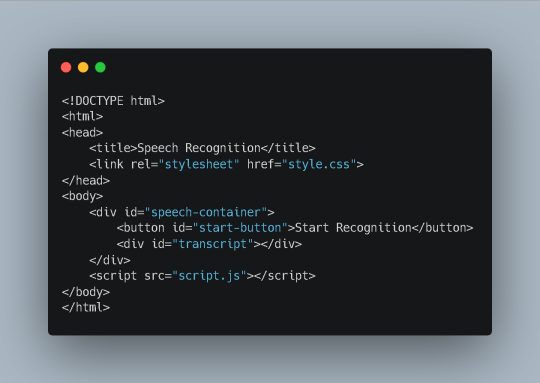
This code creates a basic HTML document with a title, a link to a CSS stylesheet (style.css), and a container (div) for our speech recognition system. Inside the container, we have a button to initiate recognition and a div to display the recognized text (transcript). Finally, we include a script tag that references an external JavaScript file (script.js) containing the core functionality.
2. CSS Styling (style.css)
Now, let's add some visual appeal to our application using CSS:

This code simply styles the elements within our speech-container div, providing a centered layout, margins, and basic button and text styling. You can customize these styles further to match your preferences.
3. JavaScript Functionality (script.js)
The magic happens in the JavaScript code. Here's what goes inside the script.js file:
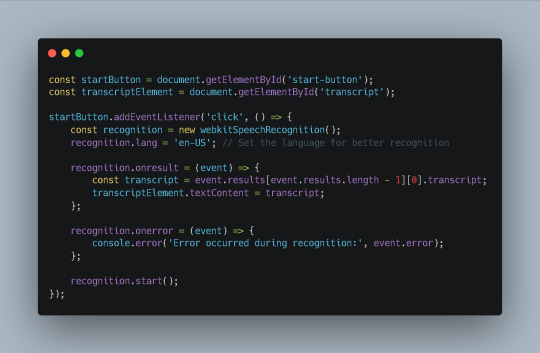
This code:
Retrieves elements: Select the start button and transcript element from the HTML document.
Adds event listener: Attaches a click event listener to the start button.
Creates recognition object: Initializes a webkitSpeechRecognition object.
Sets language: Specifies the language for recognition (in this case, English-US).
Handles results: Defines a callback function for the onresult event, which is triggered when the recognition engine receives speech data. The recognized text is extracted and displayed in the transcript element.
Handles errors: Defines a callback function for the onerror event, which is triggered if an error occurs during recognition. The error message is logged to the console.
Starts recognition: Begins the speech recognition process by calling the start() method on the recognition object.
Additional Considerations
Browser Compatibility: While webkitSpeechRecognition is widely supported, it's essential to consider browser compatibility and provide alternative solutions for older browsers.
Error Handling: Implement more robust error handling to provide informative feedback to the user in case of recognition errors.
Accuracy: Experiment with different language models and settings to improve recognition accuracy for specific use cases.
Privacy: Be mindful of privacy concerns when handling speech data, especially in sensitive contexts. Consider using secure and privacy-preserving technologies.
Conclusion
By following these steps and leveraging the power of HTML, CSS, and JavaScript, you can create a functional speech recognition system that enhances user interaction and opens up new possibilities for your web applications. Sohojware, a leading US-based software development company, is committed to providing innovative solutions and empowering developers like you to build cutting-edge applications.
FAQs
How can I improve the accuracy of my speech recognition system?
Experiment with different language models and settings.
Consider using a cloud-based speech recognition service for higher accuracy.
Provide clear and concise prompts to guide the user's speech.
Can I use speech recognition to control other elements on my web page?
Absolutely! You can use JavaScript to trigger events or manipulate elements based on the recognized speech.
How can I ensure privacy when using speech recognition?
Consider using secure and privacy-preserving techniques to handle speech data.
Inform users about your privacy practices and obtain their consent.
What are some common use cases for speech recognition systems?
Voice-controlled assistants
Transcription of audio recordings
Accessibility features for individuals with disabilities
Hands-free control of devices
Can Sohojware assist me in developing a more advanced speech recognition system?
Yes, Sohojware offers custom software development services to help you create sophisticated speech recognition systems tailored to your specific needs.
1 note
·
View note
Text
« There is so much we don’t yet know about the animals that share this world with us. Advances in AI can be used to revolutionize our understanding of animal communication, and our findings suggest that we may not have to start from scratch. »
0 notes
Text
Go Beyond Basic Chatbot: Explore Advanced NLP Techniques
In our day-to-day lives, most of us have come across using a chatbot, maybe without even knowing it. Advanced NLP Techniques help these chatbots understand human queries to provide a solution. But have you ever wondered what a Chatbot is? Or how it works and what its functions are? Let’s find out What a Chatbot is. A chatbot is a computer program that operates through the cloud(at the backend),…

View On WordPress
#Chatbot#Named Entity Recognition#Natural Language Generation#Natural Language Processing#Natural Language Understanding#NLP#NLP Techniques#Speech Recognition
0 notes
Text
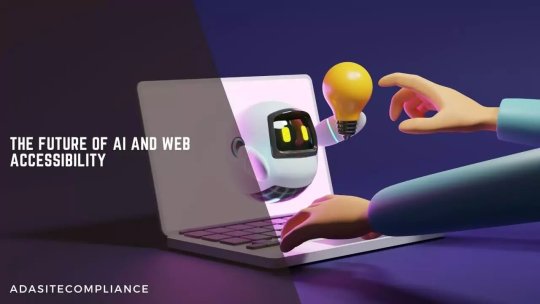
Digital Content Accessibility
Discover ADA Site Compliance's solutions for digital content accessibility, ensuring inclusivity online!
#AI and web accessibility#ChatGPT-3#GPT-4#GPT-5#artificial intelligence#AI influences web accessibility#AI-powered tools#accessible technology#tools and solutions#machine learning#natural language processing#screen readers accessibility#voice recognition#speech recognition#image recognition#digital accessibility#alt text#advanced web accessibility#accessibility compliance#accessible websites#accessibility standards#website and digital content accessibility#digital content accessibility#free accessibility scan#ada compliance tools#ada compliance analysis#website accessibility solutions#ADA site compliance#ADASiteCompliance#adasitecompliance.com
0 notes
Text
TOP 10 COMPANIES IN SPEECH-TO-TEXT API MARKET
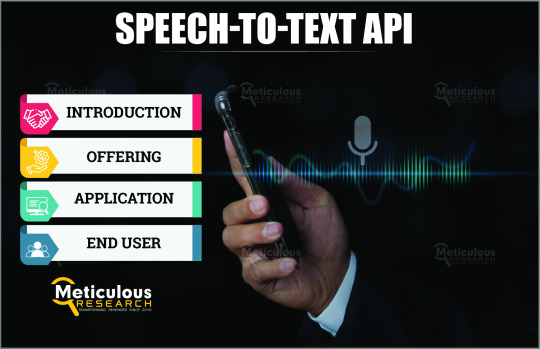
The Speech-to-text API Market is projected to reach $10 billion by 2030, growing at a CAGR of 17.3% from 2023 to 2030. This market's expansion is fueled by the widespread use of voice-enabled devices, increasing applications of voice and speech technologies for transcription, technological advancements, and the rising adoption of connected devices. However, the market's growth is restrained by the lack of accuracy in recognizing regional accents and dialects in speech-to-text API solutions.
Innovations aimed at enhancing speech-to-text solutions for specially-abled individuals and developing API solutions for rare and local languages are expected to create growth opportunities in this market. Nonetheless, data security and privacy concerns pose significant challenges. Additionally, the increasing demand for voice authentication in mobile banking applications is a prominent trend in the speech-to-text API market.
Top 10 Companies in the Speech-to-text API Market
Google LLC
Founded in 1998 and headquartered in California, U.S., Google is a global leader in search engine technology, online advertising, cloud computing, and more. Google’s Speech-to-Text is a cloud-based transcription tool that leverages AI to provide real-time transcription in over 80 languages from both live and pre-recorded audio.
Microsoft Corporation
Established in 1975 and headquartered in Washington, U.S., Microsoft Corporation offers a range of technology services, including cloud computing and AI-driven solutions. Microsoft’s speech-to-text services enable accurate transcription across multiple languages, supporting applications like customer self-service and speech analytics.
Amazon Web Services, Inc.
Founded in 2006 and headquartered in Washington, U.S., Amazon Web Services (AWS) provides scalable cloud computing platforms. AWS’s speech-to-text software supports real-time transcription and translation, enhancing various business applications with its robust infrastructure.
IBM Corporation
Founded in 1911 and headquartered in New York, U.S., IBM Corporation focuses on digital transformation and data security. IBM’s speech-to-text service, part of its Watson Assistant, offers multilingual transcription capabilities for diverse use cases, including customer service and speech analytics.
Verint Systems Inc.
Established in 1994 and headquartered in New York, U.S., Verint Systems specializes in customer engagement management. Verint’s speech transcription solutions provide accurate data via an API, supporting call recording and speech analytics within their contact center solutions.
Download Sample Report Here @ https://www.meticulousresearch.com/download-sample-report/cp_id=5473
Rev.com, Inc.
Founded in 2010 and headquartered in Texas, U.S., Rev.com offers transcription, closed captioning, and subtitling services. Rev AI’s Speech-to-Text API delivers high-accuracy transcription services, enhancing accessibility and audience reach for various brands.
Twilio Inc.
Founded in 2008 and headquartered in California, U.S., Twilio provides communication APIs for voice, text, chat, and video. Twilio’s speech recognition solutions facilitate real-time transcription and intent analysis during voice calls, supporting comprehensive customer engagement.
Baidu, Inc.
Founded in 2000 and headquartered in Beijing, China, Baidu is a leading AI company offering a comprehensive AI stack. Baidu’s speech recognition capabilities are part of its diverse product portfolio, supporting applications across natural language processing and augmented reality.
Speechmatics
Founded in 1980 and headquartered in Cambridge, U.K., Speechmatics is a leader in deep learning and speech recognition. Their speech-to-text API delivers highly accurate transcription by training on vast amounts of data, minimizing AI bias and recognition errors.
VoiceCloud
Founded in 2007 and headquartered in California, U.S., VoiceCloud offers cloud-based voice-to-text transcription services. Their API provides high-quality transcription for applications such as voicemail, voice notes, and call recordings, supporting services in English and Spanish across 15 countries.
Top 10 companies: https://meticulousblog.org/top-10-companies-in-speech-to-text-api-market/
0 notes
Text
Delhi Hearing Aid & Speech Therapy Center is a premier destination for comprehensive hearing and speech services in Delhi. Our Speech Therapy Center in Delhi offers specialized treatments to enhance communication skills and address speech disorders effectively. With a dedicated Hearing Aid shop, we provide a wide selection of advanced hearing aids and reliable Hearing aid repair services to ensure optimal hearing solutions. At our Hearing And Speech Clinic, we conduct thorough assessments, including Pure Tone Audiometry Test and Free Field Audiometry Test, to accurately diagnose hearing issues. Our experienced speech-language therapists offer personalized therapy sessions to improve speech and language abilities. Trust us for expert care and tailored solutions for all your hearing and speech needs in Delhi.
#speech development#speech#hearing voices#hearing test#speech disorder#speech recognition#hearing#hearing solution#hearing support supplement#hearing protection
1 note
·
View note
Text
#AI voice technology#Content creation#Natural language processing#Machine learning#Voice assistants#Virtual assistants#Speech recognition#Audio content#Personalization#Automation#Creative industries#Future of work#Digital transformation#User experience#Innovation.
0 notes
Text
#Web accessibility#Accessibility Initiative#WCAG#Section 508#Screen Readers#Disabilities#Universal Design#Web Accessibility Initiative#Color Contrast#Assistive Technologies#Screen Magnifiers#Speech Recognition#Low vision#Designer Accessibility#Accessibility Standards#AELData#Accessibility Audit
0 notes
Text
https://www.workbyspeech.com/
#speech recognition#voice recognition#continuous speech#speech to text analysis#customizable macros#macro recording
1 note
·
View note
Text
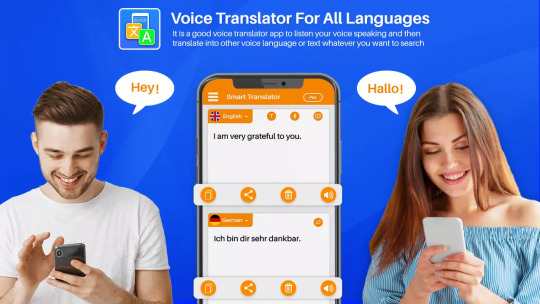
#Voice Translator#Language Translation#Real-time Translation#Multilingual Communication#Speech-to-Text#Text-to-Speech#Language Converter#Communication Tool#Travel Companion#Language Learning#Multilingual Support#International Communication#Translate Voice#Speech Recognition#Language Interpreter#Conversation Translator#Travel Language App#Language Exchange#Multilingual Dictionary#Instant Translation#Cross-language Communication#Voice Recognition#Translator App#Foreign Language Learning#Speech Translation#Language Converter App#Interpreter Tool#Multilingual Conversation#Language Services#Global Communication
1 note
·
View note